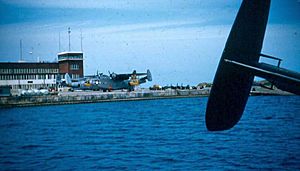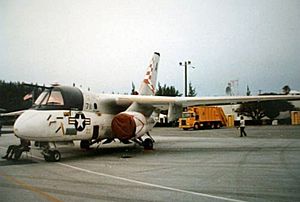Naval Air Station Bermuda facts for kids
Quick facts for kids
Naval Air Station Bermuda
|
|||||||||||
|---|---|---|---|---|---|---|---|---|---|---|---|
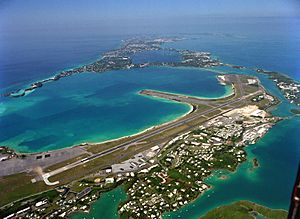
Aerial view of NAS Bermuda, 1993.
|
|||||||||||
| Summary | |||||||||||
| Airport type | Military: Naval Air Station | ||||||||||
| Operator | United States Navy | ||||||||||
| Location | St. David's Island | ||||||||||
| In use | 1970 - 1995 | ||||||||||
| Elevation AMSL | 12 ft / 4 m | ||||||||||
| Coordinates | 32°21′51″N 064°40′43″W / 32.36417°N 64.67861°W | ||||||||||
| Runway | |||||||||||
|
|||||||||||
Naval Air Station Bermuda, also called Kindley Field, was a United States Navy base. It was located on St. David's Island in Bermuda, a British territory. The base operated from 1970 to 1995. Before that, it was a US Air Force base called Kindley Air Force Base. Today, this site is home to the Bermuda International Airport.
Contents
History of US Military Bases in Bermuda
Before the United States joined World War II, an important deal was made. British Prime Minister Winston Churchill and U.S. President Franklin D. Roosevelt agreed on something called the Destroyers for Bases Agreement. The US loaned old naval ships to the British and Canadian navies. In return, the US got to use military bases in several British territories for 99 years.
This agreement helped Britain send its own forces to fight in the war. Even though Bermuda was not part of this specific exchange, the US was also given similar base rights there.
When US engineers arrived in 1940, the local government in Bermuda was surprised. The initial plan was to build a huge airfield that would take over a large part of the island. After protests, the plans were changed.
The US Army would build an airfield in the north of Castle Harbour. The US Navy would build a base for flying boats in the west. Flying boats are aircraft that can take off and land on water.
The US Navy started its operations in 1941. They used Vought OS2U floatplanes for anti-submarine patrols. These planes initially flew from a British Royal Air Force station on Darrell's Island.
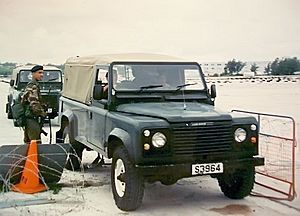
To build the main naval base, two islands, Tucker's and Morgan's, were flattened. This added about 36 acres (14.6 hectares) of land to Bermuda. The entire base covered 260 acres (1.05 square kilometers). It had large areas for parking planes and hangars. Big Martin flying boats could be pulled ashore for maintenance.
This base was first called the Naval Operating Base. Once it was fully built, the US Navy moved its air operations there. The base was used for flying boats until 1965. After that, US Navy P-2 Neptune landplanes took over the job of patrolling the seas. These planes were based at the US Air Force's Kindley Air Force Base. The former Naval Air Station was then renamed the Naval Air Station Bermuda Annex. It mainly served as a dock for US Navy ships until all US bases closed in 1995.
The US Navy moved its anti-submarine air patrols to Kindley Field in 1970. This happened after their Martin P5M Marlin flying boats were retired. These were replaced by Lockheed P-2 Neptune landplanes. The old flying boat base (the Annex) did not have a runway for these new planes.
The US Navy took full control of the airfield from the US Air Force in 1970. The base continued to operate anti-submarine patrols. First, they used Neptunes, then P-3 Orion aircraft. In the 1980s, other planes like S-3 Vikings, Canadian CP-140 Auroras, and British Nimrod aircraft also used the base.
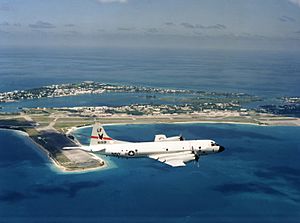
By the early 1990s, the world had changed. Submarines could launch missiles from much farther away. This meant Soviet submarines no longer needed to come close to Bermuda. Also, the Soviet Union broke apart in 1991, which reduced tensions with the US.
Because of these changes, the US Navy presence in Bermuda was reduced. The base went from having a full squadron of P-3C planes to usually just three. These were mostly from Navy Reserve squadrons. The base also had its own UH-1N Twin Huey helicopters for search and rescue.
In 1992, a news report called the base the 'Club Med of the Navy'. This report suggested that senior military officers and government officials were using the base like a vacation spot. After this, all three US Naval bases in Bermuda were chosen for closure. Except for a NASA tracking station, all US facilities in Bermuda closed in 1995.
The government of Bermuda took over the airfield in 1995. They had to spend a lot of money to make it meet international standards for civilian airports. This included changing lighting systems and fences. They also had to remove buildings and hills that were too close to the runway.
The US government still held the lease for the land. Negotiations took place to clean up toxic waste left behind. The estimated cost for cleaning up all US Navy facilities in Bermuda was $65.7 million. This included $9.5 million for replacing the Longbird Bridge. Eventually, a deal was made for an $11 million payment for the bridge. The airfield was then fully transferred to the Bermuda Government and became the Bermuda International Airport. It was also an alternative landing site for NASA's Space Shuttle.
In 1997, a contractor identified several areas needing cleanup:
- Removing oil and heavy metal pollution.
- Getting rid of asbestos, a dangerous material.
- Tearing down old and unsafe buildings.
- Replacing the Longbird Bridge, which was considered unsafe.
The total estimated cost was $65.7 million. This included $11.7 million for environmental cleanup and $30.9 million for asbestos removal. The lands where the base was located were officially returned to Bermuda in 2002.
Environmental Concerns at Morgan's Point
The military base was largely separate from the rest of Bermuda. A report in 2002 found significant pollution at the former USNAS Annex. It was estimated that 520,000 gallons (about 1.97 million liters) of oil and tons of raw sewage had been dumped into Bassett's Cave. Another 55,000 gallons (about 208,000 liters) of jet fuel were pumped underground nearby.
For over a decade after the discovery, the pollution was mostly left untouched. The base is rarely open to the public. Plans to develop the land have been stopped because of fears that the pollution could spread. If the pollution spread, it could cause huge environmental and financial problems.
Former Names of the Base
- Kindley Field and Fort Bell (1941–1948) - Used by the USAAF and US Army.
- Kindley Air Force Base (1948–1970) - Used by the United States Air Force.
See also
- USCG Air Station Bermuda (1963–1965)
- Royal Air Force, Bermuda, 1939-1945
- Military of Bermuda
- US Naval Advance Bases



